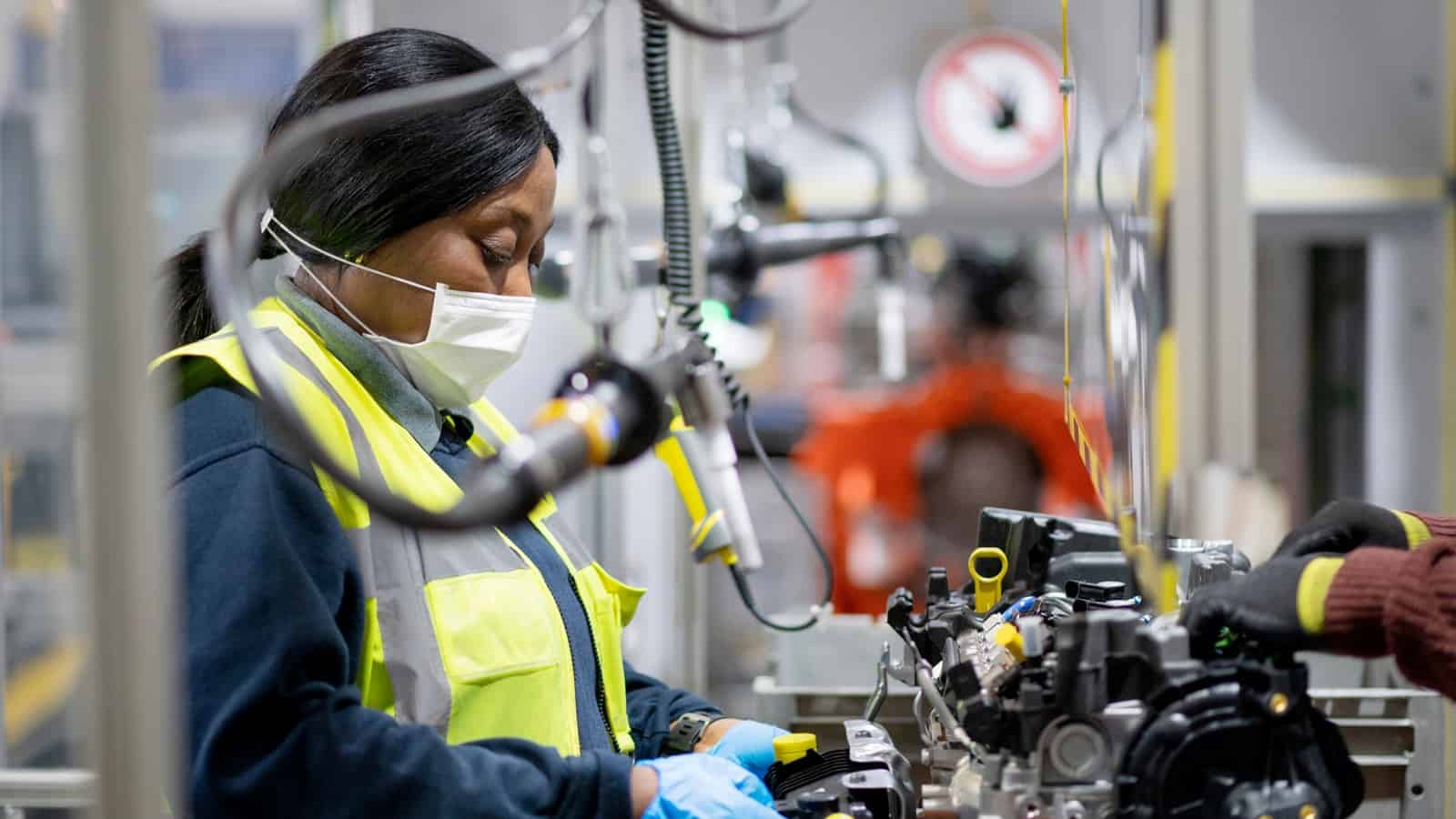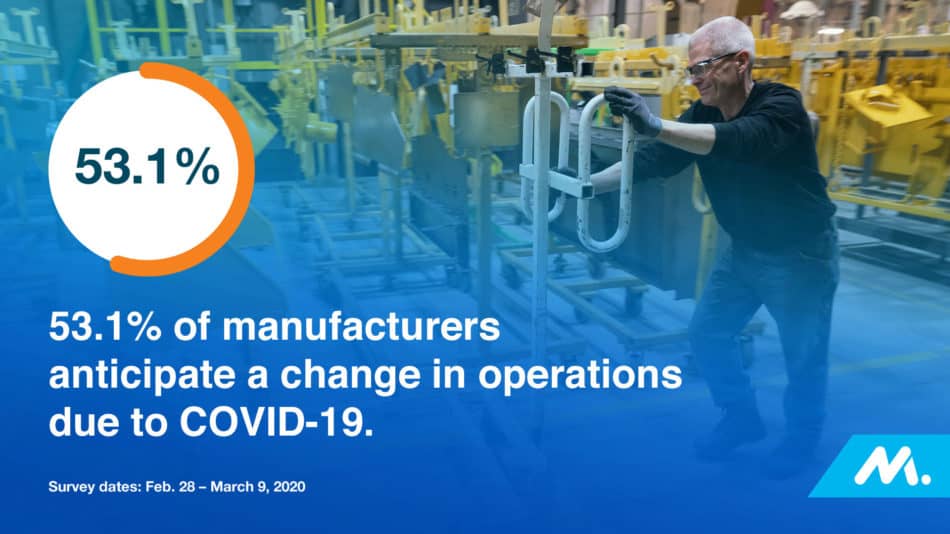2.1 Million Manufacturing Jobs Could Go Unfilled by 2030

The manufacturing skills gap in the U.S. could result in 2.1 million unfilled jobs by 2030, according to a new study by Deloitte and The Manufacturing Institute, the workforce development and education partner of the NAM. The cost of those missing jobs could potentially total $1 trillion in 2030 alone.
The study’s dramatic findings come from online surveys of more than 800 U.S.-based manufacturing leaders, as well as interviews with executives across the industry and economic analyses. All told, they paint a worrying picture of manufacturing’s labor shortage. The lack of skilled labor was the industry’s major challenge even before the pandemic, according to the NAM’s quarterly outlook surveys—and this new study shows it’s still a major concern today.
The hard data: About 1.4 million U.S. manufacturing jobs were lost during the early days of the pandemic, according to the study, setting back the manufacturing labor force by more than a decade. However, the industry has largely recovered those lost jobs and is now urgently seeking more workers.
- While the manufacturing industry recouped 63% of jobs lost during the pandemic, the remaining 570,000 had not been added back by the end of 2020, despite a near record number of job openings in the sector.
The inside scoop: Manufacturers surveyed reported that finding the right talent is now 36% harder than it was in 2018, even though the unemployment rate has nearly doubled the supply of available workers.
- Executives reported they cannot even fill higher paying entry-level production positions, let alone find and retain skilled workers for specialized roles.
- A long-term challenge: 77% of manufacturers say they will have ongoing difficulties in attracting and retaining workers in 2021 and beyond.
A bright spot: Fortunately, the study found that diversity, equity and inclusion (DEI) initiatives exert a growing influence on workforce trends and can help manufacturers fill these empty jobs. Manufacturers have more work to do to attract larger numbers of women and diverse workers to the industry, and the Institute is leading an industry-wide effort to close the opportunity gap.
Deloitte says: “Given the foundational role the manufacturing sector plays in our nation’s economy, it is deeply concerning that at a time when jobs are in such high demand nationwide, the number of vacant entry-level manufacturing positions continues to grow,” said Paul Wellener, Deloitte vice chairman and U.S. industrial products and construction leader. “Attracting and retaining diverse talent presents both a challenge and solution to bridging the talent gap. To attract a new generation of workers, the industry should work together to change the perception of work in manufacturing and expand and diversify its talent pipeline.”
The Institute says: “Manufacturers are proud to lead efforts to build stronger, more diverse and inclusive workplaces because we are committed to being the solution,” said Carolyn Lee, executive director of the Institute. “As we expand our programs at The Manufacturing Institute, and work with the National Association of Manufacturers on initiatives like our Creators Wanted campaign and tour, we’re making sure that Americans of all backgrounds in all states can find a home in manufacturing and get equipped with the skills to seize these opportunities.”
How 5G Is Transforming Manufacturing

More than half of all manufacturers will be testing or using fifth-generation cellular wireless technology (aka 5G) in some capacity by the end of 2021, according to a new study from The Manufacturing Institute. The big numbers:
- 91% of manufacturers believe 5G connectivity will be important to the overall future of their businesses.
- 91% of manufacturers indicate speed of 5G deployment will have a positive impact on their ability to compete globally.
- 88% of manufacturers indicate 5G connectivity will allow engineers to troubleshoot remotely.
All-encompassing: 5G is poised to help manufacturers in almost every part of their businesses, according to the study.
- Nine in ten manufacturers expect the utilization of 5G to lead to the creation of new processes (88%) and new businesses (86%). It can make supply chains more efficient and both machines and workers more productive. It also will likely lead to new improvements no one has anticipated yet.
Drilling down: Let’s look at just one facet of 5G’s potential impact: its effects on factory operations. This is how comprehensive the 5G transformation is expected to be:
- Four-fifths of manufacturers indicate 5G technology will be important to inventory tracking (83%), facility security (81%) and warehousing and logistics (81%) within their facilities.
- Three-fourths of manufacturers indicate 5G will also be important to inspection (76%) and assembly (76%) activities, with seven in ten saying packaging (72%) and employee training (71%) efforts will benefit from the deployment of 5G.
And let’s not overlook the fact that more than 90% of manufacturers expect cost savings of approximately 38% from their 5G connections.
Competitive advantage: “Manufacturers’ competitiveness depends on their ability to continuously improve the efficiency and effectiveness of their operations, and disruptive technologies are changing the way that firms innovate and produce,” said the Institute’s Center for Manufacturing Research Director and NAM Chief Economist Chad Moutray.
More information: You can join the Institute for a webinar on 5G technologies on Tuesday, April 6, at 2:00 p.m. ET. Register here.
How Coronavirus is Affecting Manufacturers
Manufacturers across the country are working to keep their teams and communities safe and healthy and also contending with the full range of effects—to the economy, to their supply chains, to their operations and more—of the COVID-19 outbreak. A newly released survey of manufacturing leaders conducted by the National Association of Manufacturers reveals the state of the industry as the situation unfolds.
In the survey, which was in the field from Feb. 28 to March 9, 78.3% of respondents say that the COVID-19 outbreak is likely to have a financial impact on their businesses; 53.1% of manufacturers are anticipating a change in their operations in the coming months; and 35.5% say that they are already facing supply chain disruptions.
When asked about resources that they need, survey respondents cite reliable information, including nonpolitical and non-sensationalized facts; clear and timely updates on new restrictions and health advisories; information about how other companies are reacting; clear guidelines from expert agencies like the Centers for Disease Control and Prevention and the National Institutes of Health; and early detection resources to help stop the spread of the virus.
The survey findings helped inform the NAM’s “COVID-19 Policy Action Plan Recommendations,” released earlier this week, with policy proposals for lawmakers to help contain the spread of coronavirus and ensure economic resilience.
“Already, manufacturers are grappling with disruptions to their businesses due to the COVID-19 outbreak, with many anticipating financial and operational consequences—even before some of the developments of this week,” said NAM President and CEO Jay Timmons. “The federal government can take steps to further equip manufacturers to deal with COVID-19 by implementing the NAM’s ‘COVID-19 Policy Action Plan Recommendations.’ Across the country, manufacturers are stepping up to keep their employees and their communities safe and healthy, and working closely with elected officials, we can ensure the resilience not only of our companies but also our country.”
Within a day of the plan’s release, leading members of Congress began pushing for one of its key elements, tariff relief, and both the administration and members of Congress voiced their support for key legal protections for manufacturers of protective N95 masks.
As policymakers address these issues, the NAM is continuing to convene coronavirus resources for manufacturers, connecting these businesses with guidance from appropriate government officials and agencies and providing updates on the state of the manufacturing industry.
For more information, including best practices, CDC resources and more, go to nam.org/coronavirus.
Manufacturing Output Hits All-Time High, Signaling Industry’s Strength
For the past two years, manufacturers have been setting new records when it comes to manufacturing output, and through the first quarter of 2019, the industry has continued to reach new heights.
Four out of five manufacturers remain positive about their company’s outlook, according the National Association of Manufacturers’ latest Outlook Survey, and new Bureau of Economic Analysis (BEA) data find that manufacturers’ level of output hit an all-time high once again. As noted in the recent BEA report, manufacturers produced a total of $2.3852 trillion worth of goods for the economy in the first quarter of 2019, up from $2.3845 trillion in the fourth quarter of 2018.
“Manufacturing output has consistently set new records since the beginning of 2017, and while we have seen softer data so far in 2019 than we might prefer, I would continue to expect the sector to hit new all-time highs throughout the rest of this year,” the NAM’s Chief Economist Chad Moutray said.
In fact, manufacturing accounted for 11.3 percent of real GDP in the first quarter of 2019—and the industry continues to have the largest economic multiplier of any major sector.
“At a time when conventional wisdom holds that the sector is less important than it once was, all of these data show manufacturing in the United States is alive and kicking, producing more goods than ever and continuing to be a bright spot in the economy,” Moutray said.
The industry’s continued success has created many new jobs as well. Manufacturing job openings were also at an all-time high in May with 509,000 open jobs, according to the Bureau of Labor Statistics’ Job Openings and Labor Turnover Survey. This solid job creation is actually exacerbating an existing challenge in the industry: a lack of enough skilled workers.
Manufacturers could have 2.4 million unfilled jobs by 2028 unless the right steps are taken today to build the workforce of tomorrow. The NAM and The Manufacturing Institute are leading the way toward solving this workforce crisis, and they have launched a $10 million Creators Wanted campaign, which plans to fill 600,000 manufacturing jobs by 2025.
Job Growth Sluggish in May, Highlighting Need for Certainty
The U.S. economy created just 75,000 new jobs in May, with a sluggish 3,000 manufacturing jobs created for the month.
U.S. manufacturers have experienced record growth over the past couple years, but certainty on a wide portfolio of issues, from infrastructure to trade, will be critical to keep that growth sustained throughout 2019. For policymakers in Washington, the May jobs reported should make that clear.
According to the latest Bureau of Labor Statistics jobs data, the U.S. economy created just 75,000 new jobs in May, with a sluggish 3,000 manufacturing jobs created for the month.
“Manufacturing employment has been more sluggish than desired for four straight months, coinciding with weaker demand and production activity and lagging behind the robust pace we experienced last year,” NAM Chief Economist Chad Moutray said. “Indeed, manufacturers created 264,000 net new jobs in 2018, the best pace of employment growth in the sector since 1997. Yet, the sector has added only 13,000 employees since February. For those numbers to pick back up, our leaders in Washington must recommit to tackling the issues currently creating uncertainty for businesses and focus on policies aimed at sustaining the vigorous growth the industry saw last year.”
Employment has not been the only indicator that’s lagged behind. Earlier this week, the Institute for Supply Management® said manufacturing activity in May expanded at its slowest pace since October 2016; whereas the competing survey from IHS Markit reflected growth that was the weakest pace in nearly a decade. In addition, manufacturing production has fallen in three of the past four months.
“Manufacturers need certainty,” Moutray said. “Things like ratifying the USMCA, securing a bilateral trade agreement with China, passing a long-term reauthorization of the Ex-Im Bank and enacting a bipartisan agreement to update our nation’s infrastructure are immediate steps policymakers can take that would greatly benefit the industry long into the future.”
Another factor holding back manufacturing growth is the looming workforce crisis—a challenge which continues to be the top concern for business leaders, especially in a tight labor market. The number of job openings in the sector has remained highly elevated, averaging about a half million per month over the past 12 months.
“At the end of the day, despite lower levels of industry growth, manufacturers are still creating far more open jobs than workers ready to fill them,” Moutray said. “That’s putting a damper on job creation as well.” Overall, the labor market remains tight, with the unemployment rate remaining 3.6 percent, the lowest since December 1969.
The Manufacturing Institute, the NAM’s education and workforce partner, is the leading industry authority on workforce development and recognizes the need to grow the qualified manufacturing workforce and close the skills gap. It has a range of programs and initiatives designed to do just that.
“The future of this industry and our economy at large are both tied to the future of the manufacturing workforce,” said Carolyn Lee, Manufacturing Institute executive director. “It’s just one more reason why we at the Institute work so hard every day to support the manufacturing workforce of today and grow the manufacturing workforce of tomorrow.”
Tax Reform Repeal Would Lead To Lost Jobs, Wages in U.S. Manufacturing
NAM survey data suggests repealing tax reform would strike a major blow to manufacturing jobs, wages and investments.
While some politicians in Washington and presidential candidates across the country are openly discussing rolling back key parts of the historic tax reform bill signed into law back in 2017, the National Association of Manufacturers’ latest survey data paints an alarming picture of the impact such a move would have on the U.S. economy and the manufacturing industry in particular.
According to the NAM’s Manufacturers’ Outlook Survey from first quarter of 2019, two thirds (66 percent) of manufacturers would be forced to consider cutting back investments in the United States if Congress rolled back portions of the tax reform bill, while 62 percent would scale back projected growth in wages and bonuses. Meanwhile, more than half (54 percent) would cut back on hiring.
“These are scary numbers,” Chris Netram, NAM’s Vice President of Tax and Domestic Economic Policy, said.
The Tax Cuts and Jobs Act took the U.S. tax code from one of the least competitive among advanced economies to “just about average,” Netram said. “Backsliding to uncompetitive rates and policies tells companies that operate in a global supply chain that the U.S. is not open for business. It will force them to look elsewhere.”
“Long term, the global economy will still continue to grow,” Netram said. “But the United States won’t capture as much of it.”
Because taxes are a fixed cost in any investment, raising taxes drives the required rate of return on any investment even higher, raising the threshold for what would make an investment profitable and changing the calculus for businesses planning future investments in equipment and employees.
Small manufacturers have benefited from tax reform’s provision allowing for a 20 percent deduction of “pass-through” small business income. While much of the discussion in Washington has focused on the corporate tax rate, far more manufacturers file as pass-through businesses, meaning smaller firms would bear the brunt of a full tax reform repeal.
“The number of pass-throughs dwarfs the number of corporate filers,” Netram said. “If you were looking to harm small manufacturers, reducing or repealing the pass through deduction is how you’d do it. That’s one thing that’s so alarming about what some leaders are talking about in Washington.”
The NAM has conducted its quarterly Outlook Survey since 1997. Last year’s aggregated results found the most optimistic reading among U.S. manufacturers in the survey’s history, with respondents crediting the tax reform bill as a major factor. A similar survey from 2018 found huge majorities were planning to increase investments, hiring and wages due to the tax law. Meanwhile, job growth in the industry in 2018 was the fastest in more than twenty years.
“Adopting a more competitive tax system has boosted the industry,” Netram said. “Rolling back the benefits of tax reform would make it more difficult to further grow our thriving American manufacturing sector.”



